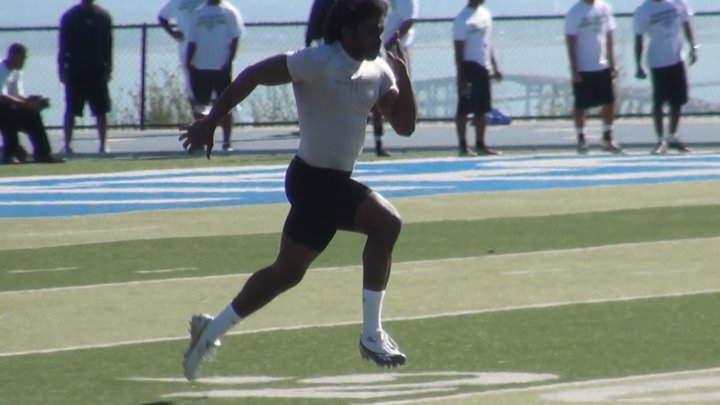Great Cornerback Technique and Mechanics
If two defensive backs with the same speed come out of their breaks, the one with lower hips is gonna be faster out of transition, and better able to make a play. Just as I said with speed training, the athlete with the better defensive back mechanics and defensive back fundamentals is gonna win.
Here I am going to show and explain some basic techniques and mechanics involved in playing DB, as well as some ways you can improve them.
Technique and Mechanics
As a great cornerback, there are some basic movements and techniques you need to know and be proficient at in order to excel at the position:
Backpedaling
The first, backpedaling, is the main technique cornerbacks use when they are covering receivers. Backpedaling is used to keep a receiver in front you so that you can read his routes and still be in a position to make a play on the ball.
It's almost a backward running motion, but there are some differences:
Your Stance
When in your stance, you should have your knees slightly bent, with your feet shoulder-width apart. You also want to bend at the hips so that your torso is almost perpendicular to the ground, with your chest over your feet.
Your feet should be slightly staggered, with your outside foot up, inside foot back.
Your arms should be loose and you should be comfortable, ready to ease or explode into your backpedal.
Coming Out
When you start your backpedal, you want to push off your front foot and skate your feet backwards, don't run backwards. Remember to keep your body in a low position to give yourself leverage when you make your break.
If you are too high in your defensive back stance, you will lose time by having to go back to a low position before you break. This makes your break slower, so stay low.
You can vary the speed of your backpedal based on how fast the receiver is running. If you are reading the quarterback, ease out by taking two slow read steps, and then immediately getting back into your backpedal and your eyes back to the receiver.
Weaving
Weaving is basically backpedaling in a diagonal direction or in a sharp left or right angle. When receivers try to "stem" you, or gain inside or outside leverage on you, you want to weave to stop them from doing so.
Weaving is also known as the cornerback "mirror" technique, because you are attempting to mirror the receiver's movement, while staying in front of him.
When weaving, you want to keep your body square with the receiver to keep yourself in good position to break.
If you turn your hips one way or the other while weaving, you open yourself up for the receiver to take advantage and break the other way.
Breaking
How good you come out of your breaks can make the difference between taking one to the house and getting beat. Breaks are that important, so you want to be very efficient at them. There are several different defensive back techniques you can use when coming out of your breaks.
You should work on being good at all of them in your cornerback drills.
T-Step Breaks
There are two main ways cornerbacks come out of their breaks using the backpedaling technique. The first one I'm going to explain is how I learned, which is the T-step. It is called the T-step because you make a "T" shape with your feet when you make your forward and diagonal breaks.
For example, when breaking to the left, you wanna stop your backpedal with instep of your right foot. Then you bring your left heel to just inside your right foot, making a "T" shape, with the toes of your left foot pointed in the direction you want to go. You then drive off your left foot hard into the direction your left foot is pointing.
My father calls it the "brake, click" because your "braking" with your outside foot and "clicking" the heel of your inside foot into the instep of your brake foot. It's a quick three-step motion with purpose of changing directions as quickly as possible.
One caveat to T-Step breaks is that when your legs get strong enough, you won't have to "click". Instead, you'll be able to just push off your back leg. Like so:
Quick-Step Breaks
The second breaking technique also widely used by cornerbacks is called the quick-step. Many players and coaches swear by the quick-step because they say you don't turn your body in another direction when you plant as you do when using the T-step.
For example, when breaking to the left with the quick-step you would use the balls of both feet to stop your backpedal, patting your feet to absorb the force, before breaking.
I feel they aren't as fast as the T-step because there are potentially too many steps are involved. They also require very powerful calf muscles in order to be fast with them and, because you're braking with the balls of your feet, they can increase your chances of getting turf toe.
Regardless of their disadvantages, it is to your advantage to work on you quick-step, so that you can be versatile in coming out of your breaks and impress any coaches who prefer them over the T-step.
Bail Technique
Bail is a defensive back technique that is starting to become widely used in football. In bail technique, a cornerback has his body turned toward the field instead of being square with the line of scrimmage.
At the snap of the ball, the cornerback runs, or "bails" out instead of backpedaling. It is more of a freestyle type of play.
Coaches say that it allows defensive backs to better see the play developing and therefore helps them react better and make plays. However, it is frequently played from an outside-leveraged position and gives up advantage on inside routes.
When playing bail technique, cornerbacks break off of their back foot.
Press Technique
Press technique, also known as "bump-n-run" or "shuffle technique," is a more physical type of play, where the defensive back plays up close to the receiver before the snap. Your goal in press is to jam the receiver at the snap of the ball, not letting him off the line, so as to throw off the timing between him and the quarterback.
Press is mostly played in man-to-man coverages, but is also used in Cover 2 to funnel the receiver inside (see zone coverages).
One of main reasons it's used is to stop receivers from getting inside on plays where the linebackers are blitzing. This is because as they blitz, an inside route becomes a very easy throw for the quarterback, and the lane is open for receivers to break into the open.
This is why it is very important to never let a receiver get an inside release when you press.
Lining Up
When pressing, you should line up close to the line (but not offsides, obviously), just inside the receiver. You want your outside foot to split the receiver's body.
You should be watching his hips, and be ready to stop any inside release. If he tries, you should already have inside leverage and jam him hard into his chest with your outside hand.
When I say hard, I mean hard enough to knock the wind out of him.
Dont Lunge
Remember to use your arms to jam, without throwing your body, or lunging at the receiver. Lunging is an almost sure way of getting you beat against good receivers.
Keep Your Feet Moving
When the receiver comes off the ball, hold your ground, but keep your feet moving. If your feet are stuck in place, receivers will take advantage and beat your press.
Don't Open The Gate
The whole point of press is to stop the receiver from getting a clean release. So, if you do line up to press don't negate it by opening up your hips and allowing the receiver to run.
Personal Expericence
When my brother was at Cal, I would go up there sometimes to get work in and do one-on-ones with their best receivers at the time, DeSean Jackson, who was also my brother's roomate, and Lavelle Hawkins, a fellow former CCSF RAM.
I decided to press DeSean.
The first time, at the snap of the ball, I got the jam and stopped his momentum. I was able to run with him down the sideline and knock the ball away.
The second time.....I blew it. I opened up the gate, and let him get a clean release, really just to see if I could....
...Well, I shouldn't have. He proceeded to turn on the jets, separate from me, and complete a deep pass for a TD.
Moral to the story: if you can stop a receiver's momentum (even a receiver with speed like "DeJack"), you can cover him.
If you open the gate....Bombs away.
Don't open the gate:
- Keep your eyes on the receivers hips/abdomen
- Keep your hands up and ready
- Keep your hips square
- keep your feet moving
- and get the JAM.













New! Comments
Have your say about what you just read! Leave me a comment in the box below.